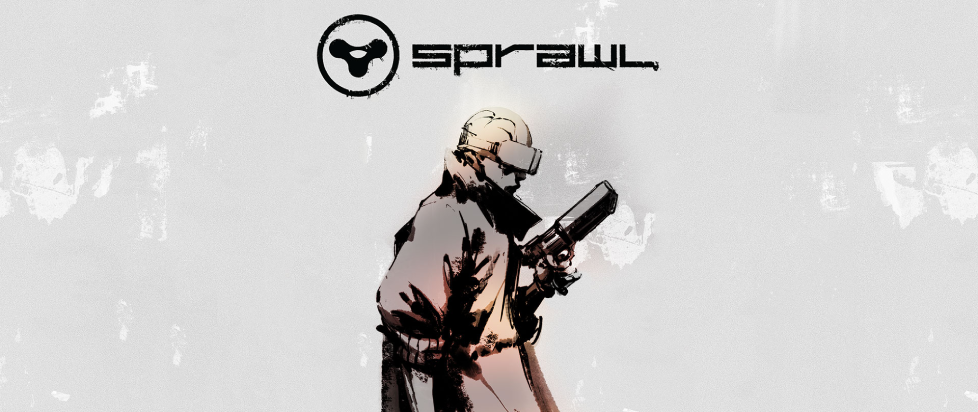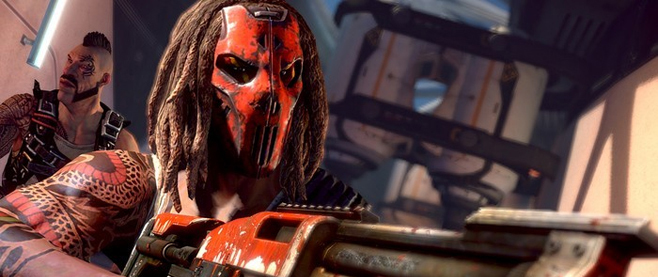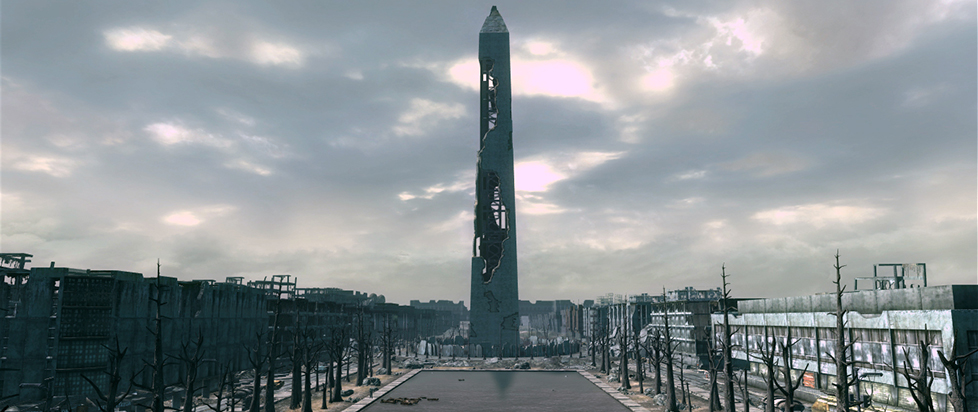
SPRAWL Kills the Past to Save It: An Interview with MAETH
When it comes to AAA gaming, the action genre is always trying to find some new angle to harness, even if it’s as simple as sitting behind chest high walls or diving through the air with bullet-time. Yet one of the most blink-and-you’ll-miss-it fads was far more elaborate: the advent of the mobility shooter. The likes of Brink, Titanfall, Call of Duty: Black Ops 3, Halo 5: Guardians and more briefly dipped into the possibility of what action games could achieve with a greater sense of fluid exploration – be it wall-running, mantling, or even cybernetically enhanced traversal options.
And then the era of movement heavy shooters was over as soon as it began, too many resistant to the ideas being embraced across the genre, shouting “boots on the ground!” so furiously that sequels like Black Ops 4 were almost unrecognizable from their counterparts. Even Titanfall was abandoned in favor of its Battle Royale alternative Apex Legends. Yet in the time since, where AAA studios struggled, indies are rising to the occasion. With the freedom to explore these ideas without decades-long built expectations of established IP, teams of agility favoring action developers are mantling back into the fray.
Among those teams is MAETH, made up of Carlos Lizarraga and Hannah Crawford, coming together for their crack at the subgenre with cyberpunk dystopian vibes in SPRAWL. Pounding EDM, relentless enemies, and scaling skyscrapers is all a day in the life of ex-assassin Seven, as she flees her old masters in service of a rebellious AI leading her through the belly of the beast.
When asked how MAETH came to be, Lizarraga recalls, “This is our first project together – and my first commercial project as well. I was a hobbyist modder for many years, predating my entry into music production. Halo CE, Quake, and various Source Engine games – you name it. Games have always been important in my life and a constant source of creative output as well.”
As for Crawford, she explains, “I got my start working on small indie prototypes and hobby projects in Unity and eventually got to the point where a studio was interested in hiring me. I met Carlos during the pandemic when I was working on the movement mechanics that later turned into SPRAWL and saw his amazing work on a community Discord. The rest is history.”
This division of skill sets would prove crucial, with Lizarraga being in charge of much of the art and sound, as well as designing all manner of enemies for players to gib. “If it moves or you can hear it or see it, I made it,” he says, citing “all the weapons, characters, levels, textures, animations and sounds.” As well as “all the music.” Meanwhile, Crawford would assemble not only the core mechanics, but the toolset needed for Lizarraga to assemble the three episodes of SPRAWL’s campaign.
This isn’t to say Crawford didn’t have input over the design. In fact, much of the game took shape collaboratively. “A lot of SPRAWL’s mechanics were improvised during calls where we’d rapidly iterate on game feel.” Crawford explains, “Working with Carlos has been invaluable because he will often ask for a feature to be added and from there we can spiral into and explore all the ways this can evolve the final product.”
As for why they delved into a movement-heavy shooter, Crawford elaborates, “Some of the biggest influences for me were Mirror’s Edge and Titanfall. I loved the wallrunning mechanics but wondered what it would be like if the wallrunning were a little bit more freeform. I started working on a prototype that ended up feeling really good.”
Yet, SPRAWL wasn’t always the mile-a-minute action first-person shooter players have come to know, as she recalls, “Initially, I’d planned to make a sort of immersive sim with wallrunning implants but the core mechanic felt so satisfying I thought it would be a waste if we didn’t use it to its full potential.” Adding that, “Once Carlos got involved in the project we leaned really hard into traditional cyberpunk influences such as Ghost in the Shell and Neuromancer for the art and lore.”

For Lizarraga, SPRAWL is “like the games you remember playing on the computer in the 90’s as you remember them; not as they actually were. It’s also a logical extension of the guiding design principles of those games. Games back then were focused on high-speed movement, the action was very frantic…” with lamentation over the compromises required to make shooters in particular work on consoles. “You had to slow things down to let people aim and move appropriately—you know, the whole floaty movement thing that happened because of Halo,” Lizarraga says, “So, the aim is that SPRAWL is a return to that form, as well as an extrapolation of it. Working within limits inspires creativity, I’ve always believed that.”
This laser focus on a retro sensibility ensured the pair could swiftly decide on several aspects. Seven would be a mute protagonist like Gordon Freeman, guided by the omniscient Father AI also seeking to rebel against the corporations. Textures would be low-poly, and graphics very chunk. However, “The retro aesthetic of SPRAWL is not by any means faithful and never was intended to be,” Lizarraga says. “It’s an amalgamation of visual styles from games we grew up with. A lot of the retro aesthetic is about understanding what the bits and pieces of those we enjoyed rather than being 100% accurate to those limits. What is it about low res textures that look good? It’s those imperfections of encoding mediums that become part of the aesthetic.”
Interestingly, this inspiration comes from Lizarraga’s other artistic love – electronic music. “Artificial noise on modern music production, etc., is a similar principle. So it’s about paying homage to the micro rather than the macro, and using it to our advantage. It allows us to elicit a feeling that isn’t actually very faithful to the 90’s or the 2000’s, but rather places it somewhere within that spectrum.”
Unsurprisingly, the dawn of FPS titles left quite a mark on Crawford, feeling “real” to her in a way few games had at that point. Crawford adds, “The technology and pure gritty vibes really speak to me. And for them to pull it off on such weak hardware and still manage to have such a gritty vibe is super impressive. I still listen to the Quake soundtrack whilst I work to really get in that zone.” Early on in the game’s production, they went so far as to assemble a homage to the first episode of Quake in their customized build of Unreal Engine 4.
Reflecting on his musical inspirations, Lizarraga adds, “I stand on the shoulders of giants. It’s something I had explored previously with a different project, only fully actualized for SPRAWL. We wanted music that reflected the themes – quite literally about the merging of humanity with technology and the challenges that arise, and how we confront them. So SPRAWL’s soundtrack is about merging traditional human elements, like tribal beats and sonics, with harsh modern electronics.”
This daring need to push further, think deeper on every front guided the project. At every turn, the pair asked themselves how to take things to the “next level”, as Lizarraga notes: “Because if you want to play Quake, you can go play Quake again. Or any one of the twenty-five million clones that have been released since then.”
With a clear goal in mind, the pair knuckled down and pondered the deeper question of what drives people in these games. What is it about relentless pacing, breathless movement, and punishing enemies that brought out unique, emergent gameplay. As they found their voice within that space, they “doubled down” on it to create an undaunting advance of action that practically demands you never stand still.
“I think the secret is keeping the things people are nostalgic about whilst keeping a lot of the objective improvements in game design that we have learned over the years,” Crawford says. “People love the aesthetics of older games like Quake, but 90% of that is the model and texture work. If you slap some complex modern lighting on top I think that only really adds to the experience. Plus, a lot of people forget that the original Quake didn’t ship with mouse and keyboard controls. WASD+mouse was invented in the Quake multiplayer scene.”
She adds, “No one is looking to play an FPS with the Goldeneye control scheme, but they want to relive the vibes.” And those vibes can include modern controllers, all manner of resolutions and framerates, and fluid movement to keep players unabated in their carnage. Interestingly, besides the obvious improvements in hardware and software, Lizarraga cites Fortnite as an example of what helped keep movement-heavy action games alive: “You have increasingly more complex movement mechanics making their return as a result. Games that have higher inputs per minute are thriving. I always point at Fortnite as being that watershed moment. Kids took that fun casual fort building experience and pushed it to its absolute limit.“
That inclination towards Fortnite becomes a tad more evident when taking into account how Crawford approached programming SPRAWL’s movement systems. Rather than moving between “states” like some games, where wallrunning is its own distinct style of movement, SPRAWL treats every moment of agility the same as if you were working, to put it simply. Crawford explains, “It’s not an on/off state, it’s something that is mixed into the calculations based on a variety of factors (how close are you to the wall, how fast are you moving, are you sliding). You can wall run on any flat surface and it doesn’t lock you into that state. I think all successful movement games have elements of this. Look at bunnyhopping in Quake or Counter-Strike – it’s something you do on top of the normal movement and you can have varying degrees of success depending on how good you get.”

That freedom is what Lizarraga points to as the defining feature of those early days in 3D action gaming, saying “It was free. It gave the player agency, it treated the player with respect. It didn’t hold your hand. Yes in many places it was rough, obtuse even, and we can improve on that, but I think a mistake that happened was – as games grew, people with vested interests in making the most amount of money possible. And those people saw any possible friction as a bad thing rather than something that makes the experience memorable.” Pointing to the success of more skill-oriented titles, he adds “Like I said, I think a whole new generation of kids is growing up wanting that experience and not having many places in the mainstream to access it, so naturally we see it exploding on the indie side.”
That scrappy sensibility at home for indie teams is readily apparent when Crawford and Lizarraga describe SPRAWL’s finer points. How the AI are given subtle little stage cues to appear far smarter than they actually are, and the dynamic music mixing allowing the game to string each chapter’s soundscape up and down in intensity alongside the action. Perhaps most amusingly, due to Lizarraga’s upbringing on Quake and other level-scripting heavy games, Crawford assembled much of the game’s level logic entities for easy implementation. What might initially sound like extra work actually saved considerable effort on a feature that can typically be difficult to manage: saving. As Crawford puts it, “Early on in development we were focused on making rapid progress and securing funding for the project, so we built a lot of content before implementing the save system. Using these little self-contained logic entities made adding in a save system ‘mostly’ painless in comparison later down the line.”
Though they both went into the project with considerable experience, the unpredictability of game development still proved quite the challenge. As Crawford puts it, “There are a lot of quirks and gotchas in game development that a lot of people run into when working on their first big indie project.” And while years of experience with large studios surround you with “decades of knowledge and wisdom”, one isn’t guaranteed to avoid “all of the pitfalls.” She cites, managing one’s own time, PR, and game direction among other “really valuable lessons from SPRAWL that I will be carrying forward into future projects. I personally get a lot of satisfaction from learning and expanding my knowledge so being able to see how different teams work has been great. Still, I think that AAA experience was definitely one of the main factors that got us across the finish line.”
Fortunately, both Crawford and Lizarraga cite that natural urge to always tinker and work on side projects, further aiding in their drive to see the project through while juggling their day jobs. Lizarraga says, “During the early days of the project before SPRAWL became my day job, it was about the bigger picture. Why am I taking a huge risk to make this game happen? It’s because we want to create something, we want to build something, and we want the freedom to explore this. So the long-term goal has always been to reach a point where I spend every day and every hour working on something special. I have no desire to contribute to someone else’s dream when I can make my own a reality.”
Crawford adds, “It’s not really a conscious thing for me, I’m one of these people that feels compelled to create and experiment with things so I’m always working on little side projects and seeing what sticks. There was a bit of a rough patch mid-development where we had kinda worked out what SPRAWL was and had implemented most of the main mechanics where it was hard to find the motivation to work on the project after a long day at the office. But having a development partner like Carlos was super important because he’s one of these people who is consistently driven. As things got closer to release I found a lot of motivation coming back. I was excited by the prospect of getting the game into player hands and really seeing the past few years of hard work coming to fruition.”
“We had to make hard choices about certain parts of the game,” Lizarraga elaborates, “features, etc., that might have made SPRAWL better, but there just simply isn’t enough time. There never will be, for any project. We will never please everyone. The hardest challenge is being okay with that, being okay with knowing that someone will point something out you were fully aware of, or wish you were.” To the team’s relief, the overall reception has been constructive and positive, though some fine-tuning with subsequent updates in response to fans on Steam and Discord.
Yet if there’s one thing the team confidently agrees on, it’s the satisfaction of their arsenal. Crawford remains admittedly torn, saying, “It’s gotta be either the shotgun for its movement capabilities (one of the earliest ideas we both had for SPRAWL) or the railgun for its overall design. I remember sending Carlos a clip of Star Wars and a clip of an F1 car and asking him if he could make the railgun sound like that, and when he came back I fell in love with how powerful it felt.”
For Lizarraga, he answers, “The double barrel shotgun. It’s perfect, it’s the best shotgun ever made. I am, of course, very humble about it.”
———
SPRAWL is available now on Steam.
———
With over ten of writing years in the industry, Elijah’s your guy for all things strange, obscure, and spooky in gaming. When not writing articles here or elsewhere, he’s tinkering away at indie games and fiction of his own.




